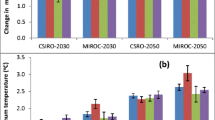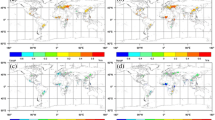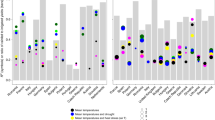Abstract
Northeast China (NEC), an important maize region located at high northern latitudes, is undergoing pronounced climate warming. This warming highlights the importance of taking the effects of brief extreme high and low temperature events into account when addressing the impacts of climate warming on crop yields. The spatiotemporal variability of heat and cold stress and their impact on yield were determined by combining climate data, maize phenological observations and yield records from 1981 to 2018 for 17 counties in the major maize cropping area of NEC. Spatially, more severe heat stress during the vegetative phase occurred in the western border and cold stress occurred in the central regions. Both stresses during the reproductive phase and growing degree days (GDD) showed a northeast–southwest gradient. Temporally, we found overall increased (0.5 °C•d/yr) heat stress during the vegetative phase, which was predominantly more than five times that during the reproductive phase. The cold stress during the vegetative phase was alleviated by an average of –1.3 °C•d/yr, particularly in the central regions. In contrast, exposure to a cold environment during the reproductive phase was intensified, with an average of 0.3 °C•d/yr, though a few downward trends mainly occurred near the borders of three provinces. The increasing trend in GDDr was 3.6 °C•d/yr, almost twice as high as that in the vegetative phase. The impact of increased heat stress contributed an average yield loss of 0.10 t/ha/10a, while reduced cold stress during the vegetative phase coupled with increased GDD increased yield by 0.42 t/ha/10a. Although cold stress during the reproductive phase had an insignificant impact on yield, its intensity together with the increase in heat stress, especially in the vegetative phase, should be considered when developing appropriate adaptations to increase maize yield in the face of ongoing warming.




Similar content being viewed by others
References
Anderegg WR, Diffenbaugh NS (2015) Observed and projected climate trends and hotspots across the National Ecological Observatory Network regions. Front Ecol Environ 13:547–552
Bailey-Serres J, Parker JE, Alnsworth EA, Oldroyd GEO, Schroeder JI (2019) Genetic strategies for improving crop yields. Nature 575:109–118
Butler EE, Huybers P (2012) Adaptation of US maize to temperature variations. Nat Clim Chang 3:68–72
Butler EE, Mueller ND, Huybers P (2018) Peculiarly pleasant weather for US maize. Proc Natl Acad Sci USA 115:11935–11940
Challinor AJ, Koehler A-K, Ramirez-Villegas J, Whitfield S, Das B (2016) Current warming will reduce yields unless maize breeding and seed systems adapt immediately. Nat Clim Chang 6:954–960
Chen C, Lei C, Deng A, Qian C, Hoogmoed W, Zhang W (2011) Will higher minimum temperatures increase corn production in Northeast China? An analysis of historical data over 1965–2008. Agric Forest Meteor 151:1580–1588
Chen C, Qian C, Deng A, Zhang W (2012) Progressive and active adaptations of cropping system to climate change in Northeast China. Eur J Agron 38:94–103
Chen Y, Zhang Z, Tao F (2018) Impacts of climate change and climate extremes on major crops productivity in China at a global warming of 1.5 and 2.0 °C. Earth Syst Dynam 9:1–27
Crafis-Brandner SJ, Salvucci ME (2002) Sensitivity of photosynthesis in a C4 plant, maize, to heat stress. Plant Physiol 129:1773–1780
Deutsch CA, Tewksbury JJ, Tigchelaar M, Battisti DS, Merrill SC, Huey RB, Naylor RL (2018) Increase in crop losses to insect pests in a warming climate. Science 361:916–919
Gourdji SM, Sibley AM, Lobell DB (2013) Global crop exposure to critical high temperatures in the reproductive period: Historical trends and future projections. Environ Res Lett 8:024041
Huang M, Wang J, Wang B, Liu DL, Yu Q, He D, Wang N, Pan X (2020) Optimizing sowing window and cultivar choice can boost China’s maize yield under 1.5 °C and 2 °C global warming. Environ Res Lett 15:24015
IPCC (2014) Climate Change 2014: Impacts, Adaptation, and Vulnerability. Cambridge University Press, Cambridge
Kumudini S, Andrade FH, Boote KJ, Brown GA, Edmeades GO, Gocken T et al (2014) Predicting Maize Phenology: Intercomparison of Functions for Developmental Response to Temperature. Agron J 106:2087–2097
Lesk C, Coffel E, Winter J, Ray D, Zscheischler J, Seneviratne SI, Horton R (2021) Stronger temperature–moisture couplings exacerbate the impact of climate warming on global crop yields. Nature Food 2:683–691
Li SF, Lian Y, Chen SB (2012) Distribution of extreme cool events over Northeast China in early summer and the related dynamical processes. Sci Geogr Sin 6:752–758
Li Y, Guan K, Peng B, Franz TE, Wardlow B, Pan M (2020) Quantifying irrigation cooling benefits to maize yield in the US Midwest. Glob Chang Biol 00:1–14
Li Z, Zhang Z, Zhang J, Luo Y, Zhang L (2021) A new framework to quantify maize production risk from chilling injury in Northeast China. Clim Risk Manag 32:100299
Liu B, Liu L, Tian L, Cao W, Zhu Y, Asseng S (2014) Post-heading heat stress and yield impact in winter wheat of China. Glob Chang Biol 20:372–381
Liu X, Wang X, Wang X, Gao J, Luo N, Meng Q, Wang P (2020) Dissecting the critical stage in the response of maize kernel set to individual and combined drought and heat stress around flowering. Environ Exp Bot 179:104213
Liu Z, Hubbard YX, KG, Lin X, (2012) Maize potential yields and yield gaps in the changing climate of northeast China. Glob Chang Biol 18:3441–3454
Liu Z, Hubbard KG, Lin X, Yang X (2013) Negative effects of climate warming on maize yield are reversed by the changing of sowing date and cultivar selection in Northeast China. Glob Chang Biol 19:3481–3492
Lobell DB, Bänziger M, Magorokosho C, Vivek B (2011) Nonlinear heat effects on African maize as evidenced by historical yield trials. Nat Clim Chang 1:42–45
Lobell DB, Hammer GL, McLean G, Messina C, Roberts MJ, Schlenker W (2013) The critical role of extreme heat for maize production in the United States. Nat Clim Chang 3:497–501
Lv S et al (2015) Yield gap simulations using ten maize cultivars commonly planted in Northeast China during the past five decades. Agric for Meteor 205:1–10
National Bureau of Statistics of China (2020) China statistics yearbook. China Statistics Press, Beijing
Prevéy J, Vellend M, Rüger N, Hollister RD, Rixen C (2017) Greater temperature sensitivity of plant phenology at colder sites: implications for convergence across northern latitudes. Glob Chang Biol 23:2660–2671
Piao S et al (2010) The impacts of climate change on water resources and agriculture in China. Nature 467:43–51
Sánchez B, Rasmussen A, Porter JR (2014) Temperatures and the growth and development of maize and rice: a review. Glob Chang Biol 20:408–417
Shaw SB, Mehta D, Riha SJ (2014) Using simple data experiments to explore the influence of non-temperature controls on maize yields in the mid-West and Great Plains. Clim Chang 122:747–755
Tao F, Zhang S, Zhang Z, Rötter R (2014) Maize growing duration was prolonged across China in the past three decades under the combined effects of temperature, agronomic management, and cultivar shift. Global Change Biol 20:3686–3699
Tian B, Zhu J, Nie Y, Xu C, Meng Q, Wang P (2018) Mitigating heat and chilling stress by adjusting the sowing date of maize in the North China Plain. J Agron Crop Sci 00:1–11
Tigchelaar M, Battisti DS, Naylor RL, Ray DK (2018) Future warming increases probability of globally synchronized maize production shocks. Proc Natl Acad Sci USA 115:6644–6649
Wang C, Linderholm HW, Song Y, Wang F, Liu Y, Tian J, Xu J, Song Y, Ren G (2020) Impacts of Drought on Maize and Soybean Production in Northeast China During the Past Five Decades. Int J Env Res Pub He 17:2459
Wang L, Liao S, Huang S, Ming B, Meng Q, Wang P (2018) Increasing concurrent drought and heat during the summer maize season in Huang–Huai–Hai Plain, China. Int J Climatol 38:1–14
Wang X, Peng L, Zhang X, Yin G, Zhao C, Piao S (2014) Divergence of climate impacts on maize yield in Northeast China. Agric Ecosyst Environ 196:51–58
Yin X, Olesen J, Wang M, Öztürk I, Zhang H, Chen F (2016a) Impacts and adaptation of the cropping systems to climate change in the Northeast Farming Region of China. Eur J Agron 78:60–72
Yin X, Olesen J, Wang M, Öztürk I, Chen F (2016b) Climate effects on crop yields in the Northeast Farming Region of China during 1961–2010. J Agric Sci 154:1190–1208
Ying J, Lee EA, Tollenaar M (2000) Response of maize leaf photosynthesis to low temperature during the grain-filling period. Field Crop Res 68:87–96
Yuan B, Guo JP, Ye MZ, Zhao JF (2012) Variety distribution pattern and climatic potential productivity of spring maize in Northeast China under climate change. Chin Sci Bull 57:3497–3508
Zaveri E, Lobell DB (2019) The role of irrigation in changing wheat yields and heat sensitivity in India. Nat Commun 10:1–7
Zhao J, Yang X, Liu Z (2009) Influence of climate warming on serious low temperature and cold damage and cultivation pattern of spring maize in Northeast China. Acta Ecol Sin 29:6544–6551
Zhao J, Yang X, Lv S, Liu Z, Wang J (2014) Variability of available climate resources and disaster risks for different maturity types of spring maize in Northeast China. Reg Environ Chang 14:17–26
Zhao J, Yang X, Dai S, Lv S, Wang J (2015) Increased utilization of lengthening growing season and warming temperatures by adjusting sowing dates and cultivar selection for spring maize in Northeast China. Eur J Agron 67:12–19
Zhang M, Liu Z, Yang X, Dong C, Liu Z (2016) Temporal and Spatial Variations of Agro-meteorological Disasters of Major Crops in China under the Background of Climate Change: Delayed Chilling Damage of Spring Maize in Northeast China. Chin J Agrometeorol 37:599–610
Zhang L, Zhang Z, Chen Y, Wei X, Song X (2018) Exposure, vulnerability, and adaptation of major maize-growing areas to extreme temperature. Nat Hazards 91:1257–1272
Zhang Q, Hu Z (2018) Assessment of drought during corn growing season in Northeast China. Theor Appl Climatol 133:1315–1321
Zhang Y, Zhao Y, Sun Q (2021) Increasing maize yields in northeast China are more closely associated with changes in crop timing than with climate warming. Environ Res Lett 16:054052
Zhang Z, Chen Y, Wang P, Zhang S, Tao F, Liu X (2014) Spatial and temporal changes of agro-meteorological disasters affecting maize production in China since 1990. Nat Hazards 71:2087–2100
Zhu P, Jin Z, Zhuang Q, Ciais P, Bernacchi C, Wang X, Makowski D, Lobell D (2018) The important but weakening maize yield benefit of grain filling prolongation in the US Midwest. Glob Chang Biol 24:4718–4730
Acknowledgements
This work was supported by Basic Research Fund of Chinese Academy of Meteorological Sciences (Grant Nos. 2021Z010 and 2020Y003).
Author information
Authors and Affiliations
Corresponding author
Rights and permissions
Springer Nature or its licensor holds exclusive rights to this article under a publishing agreement with the author(s) or other rightsholder(s); author self-archiving of the accepted manuscript version of this article is solely governed by the terms of such publishing agreement and applicable law.
About this article
Cite this article
Zhang, Y., Zhao, Y., Sun, Q. et al. Negative effects of heat stress on maize yield were compensated by increasing thermal time and declining cold stress in northeast China. Int J Biometeorol 66, 2395–2403 (2022). https://doi.org/10.1007/s00484-022-02363-6
Received:
Revised:
Accepted:
Published:
Issue Date:
DOI: https://doi.org/10.1007/s00484-022-02363-6




